Y-12 Blog
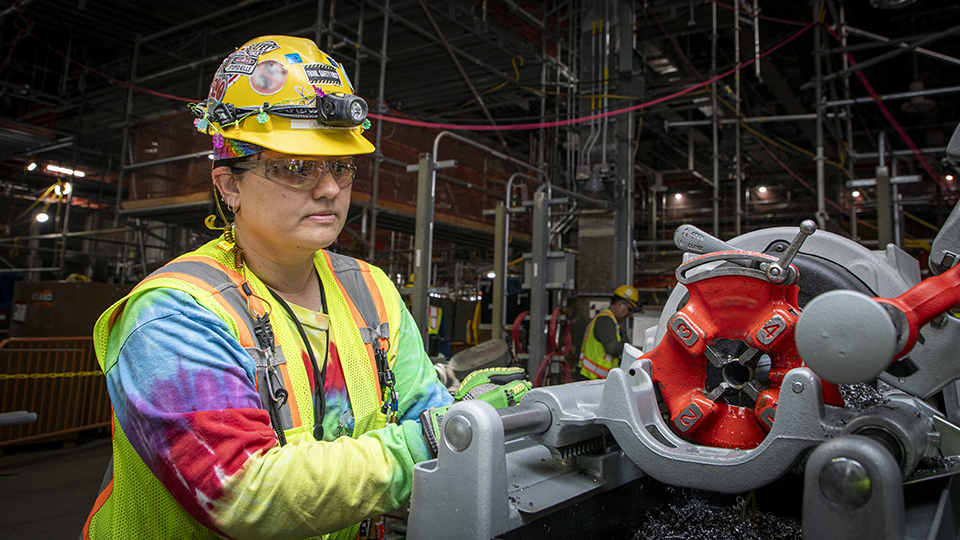
Diana C. is a journeyman wireman at the Uranium Processing Facility, and she comes from a long line of electricians.
OAK RIDGE, Tenn — Diana C. knew from an early age what she wanted her life to look like. She had a strong work ethic and knew what she needed to do to achieve her goals as she planned the path for her future.
“I’m a hands‑on‑type of person. My grandpa, uncle, and dad are all electricians out of the same union. I wanted to follow their lead, and they were very encouraging. They told me that I was built for this job. So as soon as I turned 18, I went down to the union hall and was hired,” she said of the International Brotherhood of Electrical Workers (IBEW).
Now, 25 years into her career and helping build the Uranium Processing Facility (UPF) at Y‑12 National Security Complex, she has lit the path for her daughter to follow the family tradition and become a fourth‑generation electrician. Diana sets the example for her daughter by being a go‑getter who takes pride in her craft.
“I’m representing my union hall, so I want to be the best,” she said. “I want them to know they produced a hard worker and a smart electrician. I want my product to look the best it can, and I am meticulous. I am proficient in conduit and have done wire pulling and terminating. If you know the job, you can lead; UPF finds the success in each of us.”
Not one to rest during her off time, she said she thinks about safety even when she is at home.
“You have to stay active and keep your body going to stay safe at work. I run with my daughter, and we encourage each other along the way,” she said, adding, “I am proud of her and want her to be equipped to enjoy life.”
Diana said she and her daughter will work together at home on projects or problems and often find ways to “meet in the middle.” In addition to being an encouragement to her family, she said she wants to bring that same energy to UPF.
“My crew is great — we lift each other up, and we all bring a unique perspective to the group. It’s awesome if you have a crew you can lean on. I enjoy the work, but my crew is what I love. I can communicate easily with them. The work we do is intricate, and they teach me new things every day.”
For Diana, giving her best every day helps UPF and Y‑12 achieve their missions for the nation.
“I want my family to be safe. I have family in the military, so I am going to do my part,” she said.
Her part includes leading the morning team discussions and taking the initiative to perform extra duties. Shawn S., Diana’s lead general foreman, thinks highly of her and is one of many who have noticed how she steps into leadership roles.
“She is always willing to help her crew and those around her; she is a vital part of our team. She helps get us all aligned for the day by conducting the daily Field Level Hazard Assessments and reviewing the Daily Information Sheet. She helps out wherever she is needed, and when talking to her, you know safety is her top priority. She is a craftsman that we are lucky to have on the UPF Project,” he said.
While she lights up talking about her job, Diana beams with pride when talking about her family. She is happy her daughter is going to study to be an electrical engineer and may one day be designing systems and working alongside electricians as fourth generation working in the field. She said of her daughter, “There is no reason she wouldn’t be great at this job, and I’ll be there to help build her future.”
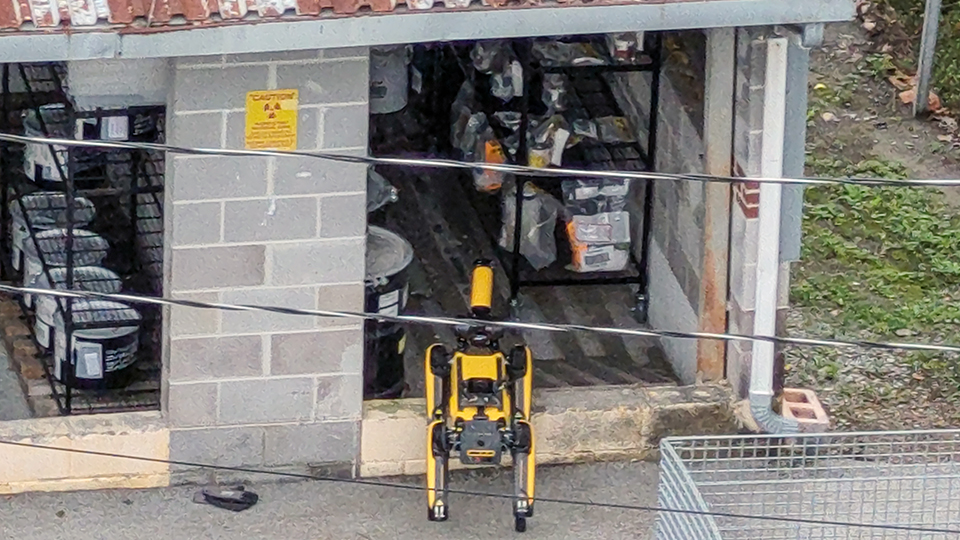
With Y-12’s emergency responders at a safe distance away, Mr. T, one of the site’s two robotic dogs, investigates an unknown chemical spill at Y-12.
OAK RIDGE, Tenn — Across the National Security Enterprise, many people work in high consequence environments. An accident involving any number of materials on site can be extremely serious. Equally serious are security incidents involving a suspicious package or an unauthorized suspect on‑site. Responding to an accident, security incident, or abnormal event comes with inherent risks. However, Y‑12 National Security Complex’s (Y‑12) application research into and growing use of technology is helping mitigate those risks when an accident occurs.
On June 19, 2025, Y‑12 emergency responders were alerted to a potential hazardous chemical spill on‑site. At the time of the initial call, what was spilled was unknown, making the potential dangers also unknown. The emergency responders requested a hand (or a paw) from the Y‑12’s Plant Directed Research, Development, and Demonstration (PDRD) Spot research project.
Spot is a Boston Dynamic quadruped robot, or robotic dog, that is being investigated as potential support for accidents, security incidents, and abnormal events for security and emergency services at Y‑12. The name “Spot” is the model designator for all Boston Dynamic quadrupeds.
Chris Burns, vice president of Safeguards, Security, and Emergency Services, summarized the situation at its onset. “Due to the concerns with the unknown materials, the fire department requested deployment of our Spot and unmanned aircraft system [drone]. The technology was used to minimize life safety impacts to our responders,” Burns said.
As one of Y‑12’s unmanned aircraft systems kept a close watch as the thermal eyes in the sky, Spot was stepped into the building to sniff (check) out the spill. Using Spot’s 360‑degree camera, first responders were able to assess the situation up close from a safe distance of 30 yards away. Outfitted with a camera on its robotic arm, Spot was able to look for the spread of the spill under and around obstacles present in the area, looking under pallets and behind barrels.
Spot was able to relay information back to emergency responders as to what was spilled and the degree of spillage. From this data, Y‑12’s emergency responders were able to be fully prepared before entering the building and cleaning up the spill.
“Life safety is our first priority during an emergency response,” said Justin Goehring, director of Emergency Management. “If I can keep responders out of harm’s way by sending in a robot, that’s a win.”
In Fiscal Year 2025, the Y‑12 PDRD program’s portfolio contained over 70 projects ranging in focus areas from safeguards and security, to production, to digital technology, to global security.
“Y‑12 is proud of the diversity of its PDRD portfolio,” declared Patrick Moehlen, director of Y‑12 PDRD. “Investments in technologies for safeguards and security enable our mission by rethinking how to conduct incident response. PDRD seeks disruptive technologies that help the plant go quicker, even if that technology serves to get us back on our feet after an upset condition impacts the site.”
“We actually have two robotic dogs,” said Joe Rainwater, one of Spot’s handlers in Security Systems and the principal investigator on the PDRD project. “We’ve named them Murdock and Mr. T, like The A Team. Mr. T was the robot that responded to the spill on June 19, and his work was “Spot on!”
Mr. T and Murdock can operate for 90 minutes on fully charged batteries. The dogs may be deployed alone or together (or with additional tools, like the robotic arm).
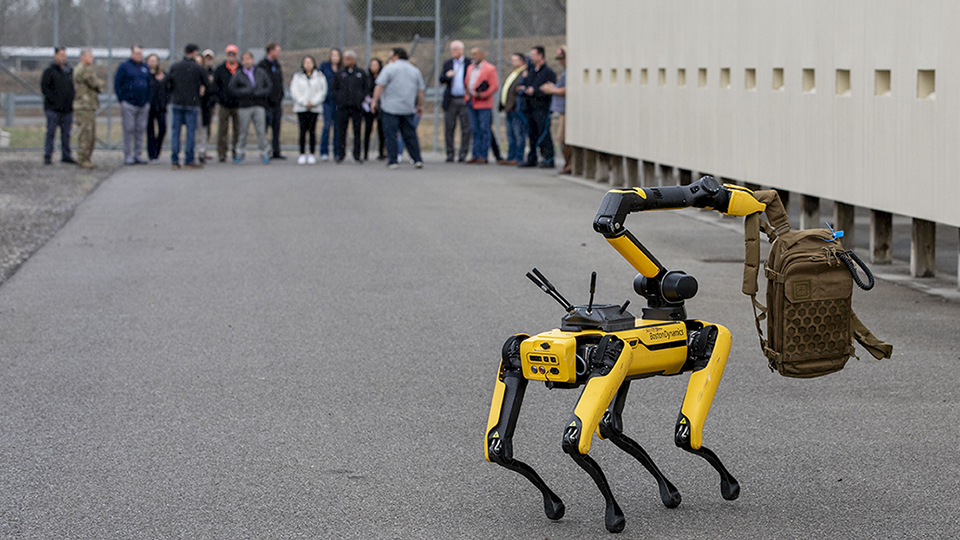
Mr. T demonstrating retrieval of a suspicious package while personnel monitor from a safe distance.
“We’ve discovered that the dogs work well in tandem, with one dog’s camera shadowing the dog with the robotic arm,” said Rainwater. “The camera helps guide operators through tasks, such as picking up objects.”
The dogs can traverse various terrains, walking on gravel, pavement, uneven ground, and even snow. They also maintain their balance when bumped or kicked.
“Being able to deploy these dogs in hazardous situations has the potential to save lives,” said Goehring. “We’re looking forward to adding them to our emergency response team.”
“Spot is changing how Y‑12 monitors and operates on‑site, ensuring the safety of our employees and community, and making data‑driven decisions,” said Moehlen. “We currently are looking to expand the capabilities of Spot with onboard chemical sensors allowing for better informed decision making.”
“And, these robots have real-world applications,” continued Rainwater. “This technology can be used in search and rescue efforts, security incidents, or environmental events by city, county, and state emergency responders, saving the lives of those who run into high‑consequence environments.”
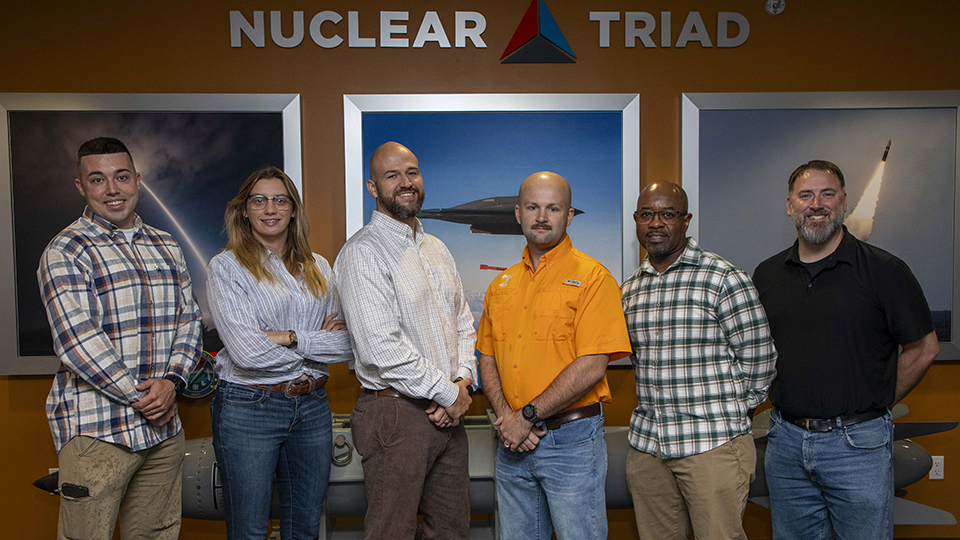
Y-12 supports our nation’s veterans with new opportunities through the Veterans to Engineers program.
OAK RIDGE, Tenn — Y‑12 is supporting our nation’s veterans with new opportunities through the Veterans to Engineers program.
VTE, which was started in 2007, gives veterans the opportunity to work at Y‑12 part‑time while pursuing a degree in engineering, with the potential for a full‑time position after completing the program.
Participants also get the chance to complete multiple job rotations while in the program. These rotations don’t just offer real‑world experience — they also show participants a variety of potential career paths to follow.
Rotations are one way that VTE Manager Matt P. encourages members to grow as engineers.
“I try to get them outside of their comfort zones,” Matt said. “I look at their strengths and opportunities for growth and align those with a rotation to gain experience in their field of study. Helping each participant develop is a nuanced process. The VTE interns are at different stages of their schooling, in different engineering disciplines, with varied backgrounds that they bring to the table. I work with them individually to identify the best path forward.”
Shannon G., a current VTE member, is making the most of his time in the program.
“My personal goal is to see what I can achieve and learn in rotations,” he said. “Learning from other engineers has been valuable, and I take something from every rotation to the next. There’s so much out here, and it’s good collaborating with other groups and speaking their language.”
Shannon previously spent 22 years in Safeguards and Security, and was in the Army and Marine Corps prior to coming to Y‑12. To him, VTE was a natural step forward.
“I had the opportunity to become an engineering instructor in the Army, and it made sense to continue something I already had experience in,” he said. “My goal has always been to not just do the bare minimum — I want to do something extra to be more valuable to the team.”
Rick S., a VTE graduate who now works in Division Managed Design as a piping engineer, found a career at Y‑12 as a result of the program.
“Engineering was always in the back of my mind — I never really loved school, but my dad was a civil engineer and I grew up around it,” Rick said. “It took an opportunity like VTE to give me the push to get the ball rolling.”
He found a variety of benefits through VTE, from experience to community.
“The biggest benefit was being able to gain practical engineering knowledge and have that experience working on site while also working on my degree,” Rick said. “Knowing there’s a place here for you when you finish school is another big benefit. We also had a tight knit group of people in my class, so it was nice knowing you were in it together.”
Growing as an engineer isn’t the program’s only focus, though. A major aspect of VTE is providing a smoother avenue as they transition out of the military.
Matt P., a veteran himself, knows how difficult that transition can be.
“Transitioning out of the military and into civilian life is shocking for many veterans,” he said. “VTE at Y‑12 helps them to find a new career.”
VTE provides many benefits for Y‑12, too. Participants can bring their experience, expertise, and education to each of their rotations, where a new perspective can make a world of difference.
“Ideally, participants will be able to bring their skills and experience from the military to the Y‑12 environment,” Matt P. said. “This lets them see problems through a different lens and navigate barriers to find success. I hope they can find meaning in mission‑driven work, and a new mission‑focused community outside of the military.”
Shannon G. agreed, saying, “Veterans have leadership experience and have learned practical applications from real life. We all volunteered and have a sense of pride and contribution.”
More information about the program can be found on the Y‑12 website. For questions, email VetsToEngineers@y12nsc.doe.gov.
“For any veteran thinking about applying — you should,” Shannon said. “Challenge yourself and you’ll be surprised at what you can do. I thought I’d be limited, but here I am learning and growing. It’s natural for veterans.”
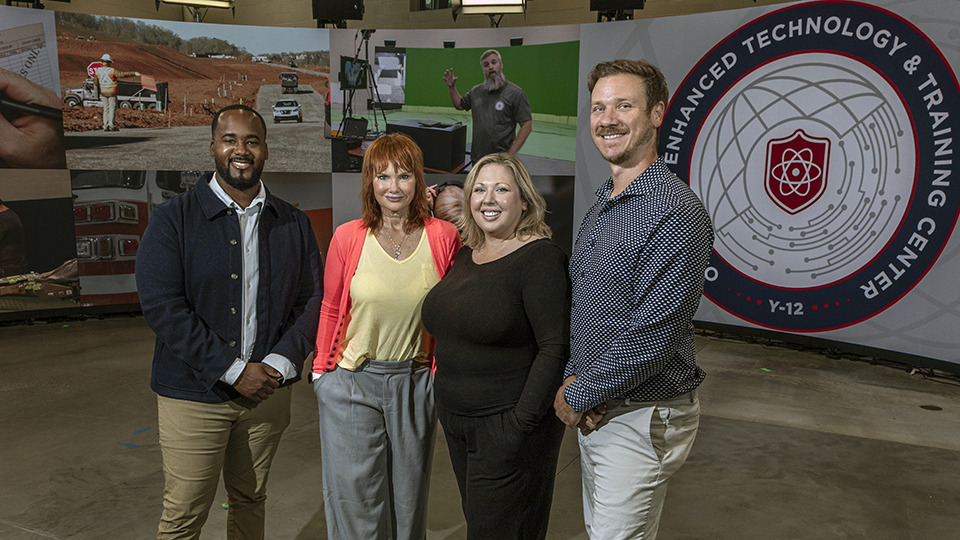
Meet the faces behind the transformative new way of learning at ORETTC: Austin A., Kelly S., Amanda W., and John K..
From Hollywood to Oak Ridge, the instructional video team brings its breadth of knowledge to advance training efforts at Y‑12’s Oak Ridge Enhanced Technology and Training Center.
This team, like many others working to meet the mission, possesses a variety of experience: a former high school teacher, media producer, director of operations and adjunct instructor, and Hollywood actress and producer.
Instructional video team member Amanda W. believes that these distinct backgrounds are one reason the team is so successful.
“Our team provides measurable, educational solutions to programs and organizations,” Amanda said. “We are a group of creative people, who come from very different backgrounds. We draw on the skills and expertise we learned in those other industries to help us employ creative problem‑solving skills on a day‑to‑day basis.”
The team produces trainings for domestic and international distribution, which entail nuclear processes, global security, and familiarization exercises. Several training formats are offered, including virtual reality, recorded videos, and full‑scale exercises. These techniques provide safe demonstrations and allow for hands‑on experiences in which participants can learn and practice without physically encountering work hazards present in the field. Through such training, widespread knowledge can be shared without the instructors (or the participants who come to Oak Ridge) ever having to leave ORETTC. Another advantage of ORETTC’s training methods is the ability to offer a means of instruction for foreign participants so they don’t have to leave their home countries.
Instructional video team member John K. sees the team’s technological training advances as its shining star.
“I’m most proud of the multiyear effort to configure, set up, develop, and strategize the usage of our LED virtual production wall,” John said. “It started as a simple, large display wall, and now, we have the ability to visualize 3D and virtual environments. We use simple tracking technologies to navigate, visualize, and interact with those virtual environments in our trainings.”
ORETTC Director Mary L., who took the helm in July, is proud to have such a dynamic team to support one of the main missions of ORETTC: training.
“The video production team at ORETTC is an effort led by seasoned professionals who have degrees in instructional design. They produce videos and deliver virtual content, with the capability of professional videographers, while using their expertise in instructional design to focus the training to meet learners’ needs.”
Not only does this group teach and train, but they are also continuing to learn. Kelly S., a member of the instructional video team, recently graduated in May 2025 from Trevecca Nazarene University with a master’s degree in instructional design.
“I was the only one on the team who was not an instructional designer,” Kelly said. “I realized, in a team of instructional designers, there was growth potential. I saw Y‑12 had educational assistance and went back to school, which gave me a new perspective on effective training delivery.”
Kelly started at ORETTC originally as a contracted role player, using her experience as an actress to support the top‑notch training. Eventually, her production experience landed her a full‑time job as a course developer and production coordinator.
Where did she get her love for producing? Her best friend and Academy Award Winner Octavia Spencer.
“I realized that I may want to make the transition from acting to producing after I coproduced a short film that Octavia directed, wrote, and produced,” Kelly said. “I always thought acting was what I loved to do, but that work made me realize I loved producing.”
Spencer believes Kelly is a valuable asset to the team because she is a “joy to work with.”
“Kelly’s commitment to fostering a collaborative creative environment and achieving maximum value is always evident,” Spencer said. “It’s fantastic that her experience, skills, and gifts now contribute to Y‑12’s mission.”
Collaboration is something the whole team uses — whether it be collaborating with each other or learning what training other organizations need, they continue to step up and raise the bar.
“Researching and developing the next generation of technology and tools for our nuclear workforce is an opportunity that I do not take lightly,” team member Austin said. “I realize, if done properly, this training technology can better prepare our existing workforce. I am proud to be part of such a dynamic and creative team and for the opportunity to have an impact on worker training and preparation.”
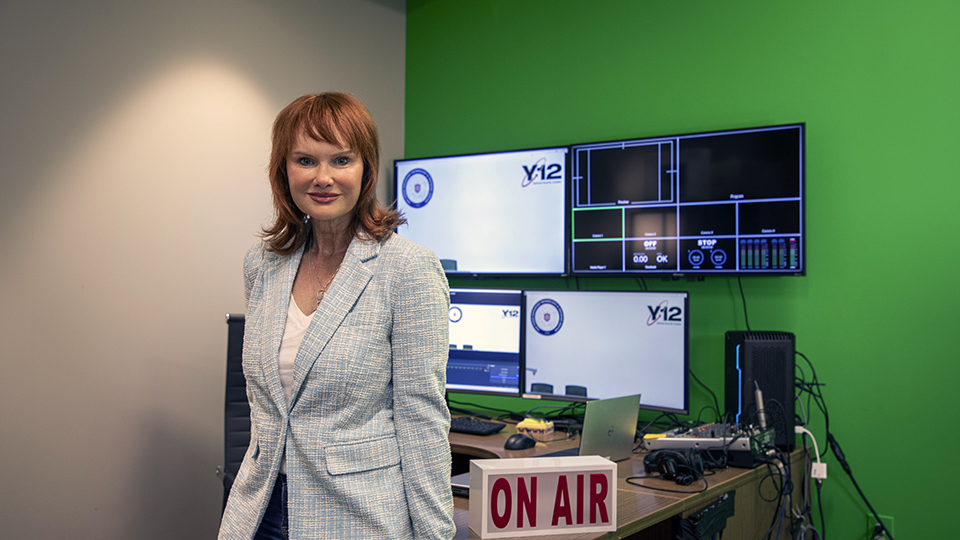
Kelly S. brings her Hollywood production experience to the state-of-the-art ORETTC production studio.
As Y‑12 continues to adapt and deliver with a variety of tasks, the ORETTC instructional video team “is a huge asset to the capabilities that ORETTC provides for preparing the current and future workforce to support the enduring mission of Y‑12,” Mary said.

Todd Ailes, chief operating officer, is excited to return to CNS. Photo by Joy Kimbrough.
The Y‑12er spotlight shines on one of our own. It takes all Y‑12 employees to make the mission happen successfully and safely. All views and opinions are the employee’s own and do not necessarily reflect those of CNS.
Todd Ailes is no stranger to the Nuclear Security Enterprise after spending more than 20 years working at various nuclear weapons sites. After a brief stint with the Department of Defense, he returned to CNS in July ready to take on a new challenge and a new site.
Ailes had been working at the Pueblo Chemical Agent Destruction Pilot Plant where he served as a project manager and provided leadership as the project completed destruction of chemical weapons and transitioned to closure of the site.
“During my time in Pueblo, I had to make sure that what was being done was right for the site and the mission, along with making sure everyone was aligned to support the mission of dismantling the chemical weapons,” he said. “Prior to my arrival, the site was not forecasting to finish on time, but we ended up safely reaching that treaty deadline through the strong disciplined operations and alignment put in place.”
Before his position at PCAPP, Ailes spent 15 years at the Pantex Plant as the vice president of Plant Operations and site manager where he learned the importance of teamwork and coordination to meet the mission.
“We have to work together more,” he said. “We need teamwork to get programs authorized, readiness activities completed — and to deliver safely on time for our customer.”
Ailes sees teamwork as foundational to the Y‑12 mission, as even the enterprise must work together to reach the ultimate goal.
“Throughout my time at nuclear weapons sites, I’ve learned from other folks and made better decisions when there was collaboration,” he said. “I always support getting more people involved so that there is a greater opportunity for issues to be identified and resolved. I look forward to bringing this thinking to site operations at Y‑12 and ensuring no employee is ever left on an island, which is when larger mistakes can occur.”
What excites you about your new role?
I am excited to return to the CNS family. I am excited about the mission and the importance of the mission. I am looking forward to being more ingrained in the group that I worked with from afar before. I am also looking forward to this new challenge of learning more about operations at Y‑12 and how the mission is met here.
What characteristics define a good leader to you?
A good leader has to be humble, be willing to lead by example, and understand what other folks are going through to accomplish their jobs. Assuming everyone starts with good intent, even if a mistake is made, allows a better perspective. I am also proud of what I have done to contribute to future leaders’ development.
What is something you are looking forward to doing now that you live in East Tennessee?
After I get settled in, I look forward to taking the opportunity to experience the state and countryside. I’ve lived in West Texas for approximately the last 20 years; I’m used to seeing things coming from miles away. Being able to experience trees, water, and rolling hills will be a nice change of scenery. I also have a niece that started playing college volleyball in Tennessee, and I look forward to supporting her at her games.
What advice do you offer someone who has made a mistake in his or her job? How should the individual be accountable for that issue?
You don’t want mistakes to happen, but they are a part of life. I want to ensure people and the organization learn from their mistakes. When a person owns the mistake, learns from it, and makes adjustments, it will lead to better decision‑making in the future.
Share a lesson learned from a leader in your past. Why was the lesson good (or bad)?
No matter where you go, you have to prove yourself all over again, and I am looking forward to doing just that here at Y‑12.
